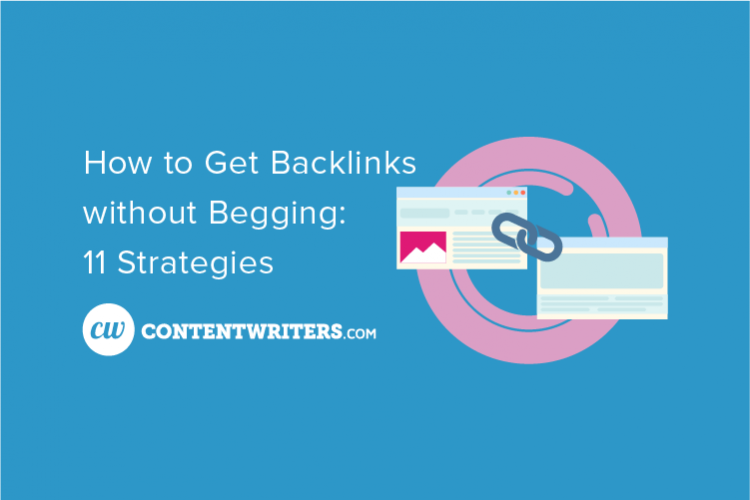
How to Get Backlinks without Begging: 11 Strategies
Building and maintaining a website with good SEO is a constant balancing act.
You can’t focus on one important pillar only to neglect another, otherwise your efforts in one area might ultimately be for nothing.
Necessary website SEO tasks are often broken down in terms of three major categories:
- Website technical structure: Ensuring that your website offers a straightforward user experience in terms of page speed, mobile responsiveness, navigation, use of HTTPS, and so on.
- Onpage SEO: Publishing quality content based on keyword research.
- Offpage SEO: Gaining authority for your website from other websites, passed on via backlinks.
Those who don’t know much about SEO oftentimes underestimate the importance of backlinks. They shrug it off as unimportant because they don’t understand why backlinks matter and the impact they can have on your website’s ability to rank in relevant search results.
Let’s change that.

The Importance of Backlinks
To properly understand the importance of backlinks, it’s necessary to first discuss two concepts: domain authority and keyword difficulty.
Domain authority, a phrase coined by popular SEO tool MOZ (another popular SEO tool, Ahrefs, refers to the same concept as domain rating), measures the perceived authority of your website in terms of other websites linking to it.

Put another way, Google makes decisions around what to display in search, in what order, based on how other websites lend their authority to a website via links.
Domain authority is measured from a scale from 1 to 100, with it becoming increasingly more difficult to jump from one number to the next as your domain authority gets closer to 100. If you’ve ever signed up to get your Klout score (RIP) or played Pokemon Go, you’ll be familiar with this same leveling concept.

Keyword difficulty works in much the same way as domain authority, as it is also measured from 1 to 100 (and it’s similarly harder to rank for keyword difficulties as they approach 100). This metric helps you determine how hard it would be to rank for a given keyword. The reason that it’s worth discussing keyword difficulty at the same time as domain authority is because your domain authority will have a direct impact on your ability to rank for target keywords.
As such, it’s important to go into keyword research with an understanding of your domain authority. You don’t want to waste time trying to target keywords with a high difficulty unless you’re a top website in the industry.
In order to increase your likelihood of ranking for the terms you’re targeting, you’ll want to proactively work to build your domain authority. The best way to do that involves building backlinks.
How to Be Backlink-Worthy: 10 Ideas
So here’s the thing about building backlinks: executing outreach tasks are not all that different from sending cold emails to prospects.

As such, for those who are put off by salespeople, you may feel like the art of backlink building involves being pushy and essentially begging various outlets to give you a link.
But it doesn’t have to be this way. The following tactics for backlink building primarily focus on creating quality content and making others in your industry aware of it.
Here are 10 ideas for building backlinks without begging:
#1: Create an In-Depth Industry Resource
Create mega resources on topics of importance to your audience. For example, Ryan Robinson’s How to Start a Blog mega guide ranks high in search and generates tens of thousands of dollars in affiliate revenue for him each month. Offering in-depth, step-by-step guides make it easy to justify linking to your website’s content when people are looking for additional resources to share in related articles.
Like our guide to how expensive it is to hire writers.
#2: Publish Original Research
Blog articles written for professional purposes often link to external statistics and studies to help validate points made. So why not put forth the effort to gather your own original research and publish this information for other people to use (and link to!)?
Orbit Media Studio’s annual blogger study provides an excellent example of this tactic in action. It’s often quoted and linked to by many reputable industry publications once new findings are released.
#3: Be Controversial
Publish industry thought leadership that makes people think. Try writing from a perspective that other people haven’t heard yet or wouldn’t expect. For ideas to spark your creativity, see what’s getting shared on Medium via their weekly content roundup newsletter.
#4: Publish Expert Roundups that Provide Value
In other words, don’t ask super generic questions and don’t just publish people’s answers without weaving ideas together and clarifying takeaways for the reader. Databox regularly publishes useful expert roundups that act as a great example for this tactic.
#5: Create Infographics to Complement Written Content
Adding supplementary media, like infographics or video, can help add dimension to your content and convince people that it’s worth linking to. Platforms like Easel.ly and Visme provide affordable infographic design services that anyone can use.
#6: Create a “Best of” List Featuring Industry Influencers
People love sharing awards they’ve won and “best of” lists that they’re part of on their websites. By publishing your own “best of” list, you’re creating an easy opportunity for influencers to link back to you. One Woman’s Shop list of the best sites for solopreneurs provides a good example of this tactic to inspire your own efforts.
#7: Suggest a Link from an Unlinked Mention
Some people claim that journalists shouldn’t link to brands mentioned in news stories, so don’t expect to make a lot of headway if that’s the type of content creator you’re negotiating with. But everything else, like company blogs, is fair game with the right approach.
Use a tool like Awario for general mention tracking, which starts at $24/month when paid yearly.

#8: Sponsor a Charity or Conference
Although it’s not begging, getting a backlink via sponsorship still requires setting a budget around your backlink building efforts. Google doesn’t always like that — in fact, it’s against their terms of service to pay for backlinks. As that’s not necessarily the main reason people sponsor initiatives, you shouldn’t worry that you’ll get in trouble for spending money to get this type of backlink.
#9: Pitch Content Creators via Help A Reporter Out
Help a Report Out (HARO) is a thrice-daily email newsletter where journalists, organized by the subject they’re reporting on, can ask for expert contributions to pieces they’re working on. Cision, a PR database software tool, is the parent company behind this offering.
HARO is free to sign up and submit responses to queries but you’ll have to have a top million website (or write for one) in order to be able to request queries from others.
To find success with this backlink building tactic, you have to offer truly thoughtful and useful advice. You also have to respond in a timely manner, as most content creators using the service have tight deadlines.
In my experience, HARO is one of the most approachable ways for taking control around backlink building efforts.

#10: Try Guest Blogging
Another one of the most effective ways to take backlink building into your control is by pitching content ideas to popular industry outlets. It’s on you to do the due diligence necessary to determine if an outlet grants do-follow links (or, links that pass on authority to your website, versus no-follow links, which don’t) — otherwise this effort won’t directly help with backlink building (though your article could still attract links from readers).
WPMU DEV shares a guide for approaching this aspect of backlink building. You’ll either want to place links in the body of the article copy or in the author bio. Note that most outlets will want to limit your backlink placements to your author bio.
A similar tactic for sharing your insights while generating backlinks is being a podcast guest (and getting a link back from the show notes). If you don’t like writing, this may be a more natural fit for building backlinks.
Still looking for more ideas? Backlinko shares advanced techniques for backlink building if you want to mix things up.

Backlink Request Pitch Email Template
Even once you’ve created the content, the work isn’t done. Great content will likely earn backlinks on its own, if you’ve done your due diligence around content promotion and distribution. But you will also need to do some email outreach around your backlink building efforts in order to continuously build domain authority.
Though each of the aforementioned backlink building tactics requires a slightly different approach, you’ll want to create a basic process around your email outreach effort.
Start with this template and customize it for these various types of pitches, as well as your own brand personality:
Hello [Name],
I really enjoyed [Company’s] last article about [Topic]. It’s a great resource for people in the [vertical] industry, so I shared it with my Twitter followers (add link to show that you’re not making this up).
We recently published a resource that your readers might find complementary to your article: [Topic with link]. Would you be willing to reference this resource in your article — perhaps in this sentence?:
[Share suggested copy]
We set forth to create the best resource about [topic] and would be grateful if you could help us reach more people who are looking for answers to their questions. Please let me know how [Your company] can help you out in return! For example, we could [share it on company social channels, on your email newsletter, or offer free access to a resource].
I’m looking forward to chatting about this in more detail!
Thanks,
[Name]
[Title/Your company]
How to Get What You Want: Backlink Negotiation 101
Not all backlink emails are the same — in fact, some backlink requests are just annoying.
To put your best foot forward when it comes to sending backlink request outreach emails, consider the following tips:
- Customize the template to be personal and seem thoughtful in terms of your recipient. It’ll be harder for them to ignore and harder for them to reject your request without a good reason.
- Suggest a specific page where the backlink should go and the written copy to go with it. This takes the guesswork out of someone’s job when it comes to placing your backlink.
- Answer, “What’s in it for me?” on behalf of the person who you’re asking to grant a favor. The next section of this article can help you figure out how best to approach this.

How to Repay the Favor of Placing a Backlink
Don’t suggest a backlink trade — it’s like asking for a testimonial on LinkedIn and automatically giving the other person one in return. What I’m trying to say is that it doesn’t look as authentic when you’re trading links. If you get into the habit, it will be easy for human visitors or Google spiders to see.
Instead, offer to provide value in terms of something else you can help with, such as:
- Sharing the resulting article update with your social followers. This is only really compelling if you have a good/relevant following.
- Including the post in your email newsletter (if you have a decent-sized list).
- Giving free access to your products or services (like one year access to a software service your company offers).
SEO Tools to Track Backlink Building Efforts
If you’re going to put the effort into building backlinks, you might as well take the time to measure your effectiveness. You’ll want to invest in some tools to help make this job easier.
The two most important functionalities you want out of a tool for measuring backlink building efforts are backlink tracking and keyword ranking tracking. Backlink tracking notifies you as you gain or lose backlinks and keyword ranking tracking helps you understand how your website is ranking for the keywords you’re targeting (which is important because of how your website’s domain authority impacts your ability to rank).
Unless you’re an enterprise company with an enterprise budget, the best all-in-one SEO tools for the job will be Ahrefs or SEMrush.
SEMrush will be a better fit if you also do a lot of PPC advertising. There’s also Majestic but it’s focused almost entirely on backlinks when compared with these other tools that offer all-in-one features at the same price. Ahrefs, SEMrush, and Moz each offer plans starting around $99/month.
If you’re looking for a budget option, Serpstat (plans start at $55.20/month when paid yearly) and SE Ranking (plans start at $31/month when paid yearly) are your next best bets.
Serpstat is a little more limited in that it offers keyword ranking tracking but does not track backlinks. SE Ranking offers rank tracking and manual backlink monitoring, which will be a more tedious process than what you’d get using Ahrefs, SEMrush, or Majestic. Note that both Serpstat and SE Ranking offer several all-in-one SEO tool features that make them useful for more than just backlink-related measurement.
Besides using SEO tools to assist your efforts, you’ll also want to keep track of who you’ve been emailing and who you should follow up with. The low tech method? Use Gmail’s snooze functionality to resurface emails that may require follow up. A more organized option would be to create a backlink tracking spreadsheet on Google Sheets.
Search Engine Journal offers additional suggestions for backlink tools and keyword rank tracking tools.
Final Thoughts: How to Get Backlinks without Begging
Understanding specific strategies for building backlinks can make the process feel a little less overwhelming. There’s no need to master them all — pick a few favorites and fine-tune your approach over time as you observe how recipients react.
Maddy Osman creates engaging content with SEO best practices for marketing thought leaders and agencies that have their hands full with clients and projects.





